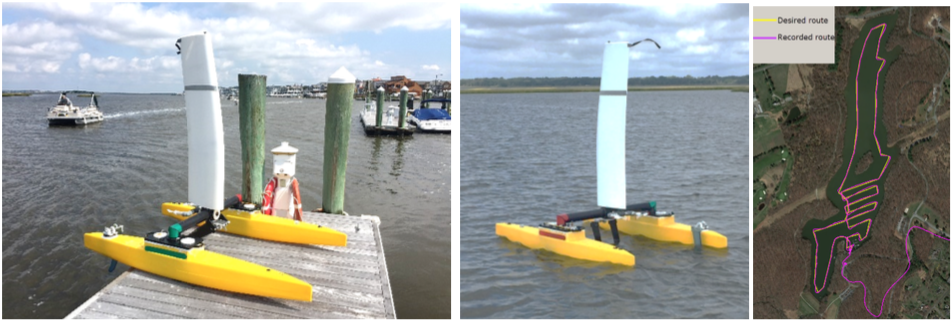Prev-Talk | Next-Talk | All-Talks | Talks-Sorted | MOOS-DAWG'19
Talk-24: An Autonomous Sailing Marine Robot For Long Endurance Observation In Shallow Water
Vincent Vandyck and Walter Holemans, Marine Robotics, LLC
We will present on the basic capability of mass producible autonomously sailing robotic boats that employ MOOS-IvP. We have been developing this technology to service the tide-water bays and rivers in regions like the mid-Atlantic USA. Typical of this tidewater environment is shallow, (typically 1 to 3-foot depth) saline water. It is typically polluted, exhausted and highly trafficked. Low cost (autonomous) marine observation greatly aids the communities and industry by providing real-time measurements of pH, depth, wind, oxygen, nitrogen, current and temperature. Aquaculture relies on marine observation as ‘weather’. It greatly reduces the cost of determining ideal planting and harvesting time, and to observe disease and growth. It helps regulators detect, localize and remediate detrimental inputs to aquaculture (sewage, sediment and salinity). The vast scale of the bays (Chesapeake, Delaware and Albemarle) and the growing human and aquaculture activity necessitate much greater understanding of these littoral regions to avoid a repeat of past degradation and to restore productivity [1].
We will also present arguments for what software developments would be most useful in the near term (anti-collision, autonomous June 21, 2019 sailing) and farther ahead (optimized swarms) and even farther ahead (tele-robotic marine worker).

About US
The robotic sailboats manufactured by Marine Robotics are designed to sail in shallow waters typical of shellfish beds near beaches, marshes, docks and navigation channels. The 8-foot long, 150-pound catamaran travels as fast as walking. It uses a sail to propel the boat to increase endurance and visibility. Electric thrusters enable complex maneuvering and propulsion without wind. Solar panels power the boat’s instrumentation. Satellite modems transit data. We anticipate deploying tens of thousands of boats in support of the shellfish industry. Marine Robotics founders have been operating robotic sailboats in the Chesapeake Bay since 1996.
[1] Sustainable oyster aquaculture can produce about $19 billion in revenue and about 50,000 jobs in the Chesapeake Bay. At its peak in the 1880’s the Chesapeake oyster industry used 700 ships, its own armed police force and several railroads to supply 1/3rd of the world’s oysters. Under-regulated harvesting, disease and pollution led the harvest to decline by 99 percent since then, but is now rebounding due, in part, to aquaculture.
Photos:
Categories:
- USVs
- Autonomous Sailboats
- Environmental Monitoring
- Aquaculture
- Long Duration Missions